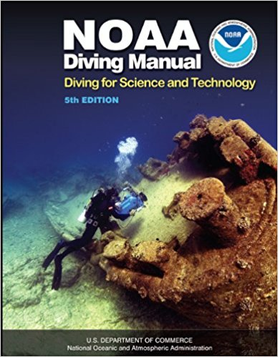NOAA Diving Manual
NOAA Diving Manual[edit | edit source]
The NOAA Diving Manual is a comprehensive guide to scientific diving and underwater operations, published by the National Oceanic and Atmospheric Administration (NOAA). It serves as an essential resource for divers involved in scientific research, providing detailed information on diving techniques, safety protocols, and equipment.
History[edit | edit source]
The NOAA Diving Manual was first published to support the needs of NOAA's scientific diving program. Over the years, it has been updated to incorporate the latest advancements in diving technology and safety practices. The manual is widely used by scientific divers, commercial divers, and recreational divers who seek to enhance their knowledge and skills in underwater operations.
Content Overview[edit | edit source]
The manual covers a wide range of topics essential for safe and effective diving. These include:
Diving Physics[edit | edit source]
The section on diving physics explains the principles of buoyancy, pressure, and gas laws that affect divers underwater. Understanding these principles is crucial for managing buoyancy and avoiding decompression sickness.
Diving Physiology[edit | edit source]
This section delves into the physiological effects of diving on the human body, including the impact of pressure changes on the respiratory system, circulatory system, and nervous system. It also covers the symptoms and prevention of diving-related illnesses.
Diving Equipment[edit | edit source]
The manual provides detailed information on the selection, maintenance, and use of diving equipment. This includes scuba gear, rebreathers, and specialized equipment for technical diving.
Diving Procedures[edit | edit source]
Diving procedures outlined in the manual include pre-dive planning, emergency protocols, and post-dive assessments. These procedures are designed to ensure the safety and efficiency of diving operations.
Specialized Diving Techniques[edit | edit source]
The manual also covers specialized techniques such as underwater photography, underwater archaeology, and deep-sea exploration. These techniques require additional training and equipment to perform safely.
Importance in Scientific Diving[edit | edit source]
The NOAA Diving Manual is a critical resource for scientific divers who conduct research in marine environments. It provides guidelines for conducting safe and effective underwater research, including data collection methods and environmental considerations.
Related Pages[edit | edit source]
| Diving | ||||||||||
|---|---|---|---|---|---|---|---|---|---|---|
This diving-related article is a stub.
|
Search WikiMD
Ad.Tired of being Overweight? Try W8MD's physician weight loss program.
Semaglutide (Ozempic / Wegovy and Tirzepatide (Mounjaro / Zepbound) available.
Advertise on WikiMD
|
WikiMD's Wellness Encyclopedia |
| Let Food Be Thy Medicine Medicine Thy Food - Hippocrates |
Translate this page: - East Asian
中文,
日本,
한국어,
South Asian
हिन्दी,
தமிழ்,
తెలుగు,
Urdu,
ಕನ್ನಡ,
Southeast Asian
Indonesian,
Vietnamese,
Thai,
မြန်မာဘာသာ,
বাংলা
European
español,
Deutsch,
français,
Greek,
português do Brasil,
polski,
română,
русский,
Nederlands,
norsk,
svenska,
suomi,
Italian
Middle Eastern & African
عربى,
Turkish,
Persian,
Hebrew,
Afrikaans,
isiZulu,
Kiswahili,
Other
Bulgarian,
Hungarian,
Czech,
Swedish,
മലയാളം,
मराठी,
ਪੰਜਾਬੀ,
ગુજરાતી,
Portuguese,
Ukrainian
Medical Disclaimer: WikiMD is not a substitute for professional medical advice. The information on WikiMD is provided as an information resource only, may be incorrect, outdated or misleading, and is not to be used or relied on for any diagnostic or treatment purposes. Please consult your health care provider before making any healthcare decisions or for guidance about a specific medical condition. WikiMD expressly disclaims responsibility, and shall have no liability, for any damages, loss, injury, or liability whatsoever suffered as a result of your reliance on the information contained in this site. By visiting this site you agree to the foregoing terms and conditions, which may from time to time be changed or supplemented by WikiMD. If you do not agree to the foregoing terms and conditions, you should not enter or use this site. See full disclaimer.
Credits:Most images are courtesy of Wikimedia commons, and templates, categories Wikipedia, licensed under CC BY SA or similar.
Contributors: Prab R. Tumpati, MD

